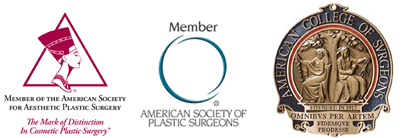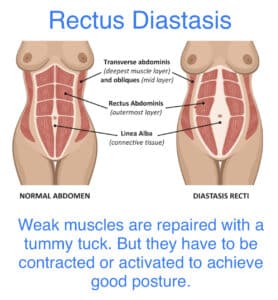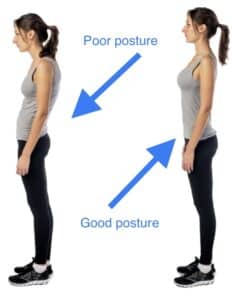Even after a tummy tuck, your muscles are soft or flaccid unless your body activates and contracts them. To look your youngest and flattest, you must contract your abdominal muscles. If you have had a tummy tuck or an abdominoplasty, you will look better, smaller, and thinner. But the best post operative result will happen after you learn to tighten or contract the stomach muscles to get your maximal benefit. The simultaneous contraction of the stomach and buttock muscles is necessary for proper posture. Without contraction or activation of these muscles, the stomach pooches out and the back sways. This is the classic appearance of bad posture. The importance of contracting these muscle groups is reviewed in this educational writing. It was written at the request of a patient from Baltimore, MD. A similar topic is reviewed for facial rejuvenation and improvement of a SAD face or a turned down face. This appearance is often called a “Resting Bitch Face.” This is caused by flaccid facial muscles. Improvement involves contraction of the muscles of facial animation.
Muscular Contraction and Posture:
I explain this concept most frequently after a tummy tuck or an abdominoplasty operation. Patients have their muscles tightened by me in two layers with imbrication. I call this my CALIFORNIA CORSET muscle repair. It’s an extra tight repair that I developed after my 8 years of surgery at the University of California. It’s a wonderful and strong muscle repair. For those interested in the CALIFORNIA CORSET in more detail, please link now. But despite this muscle tightening, patients will stand in my office after surgery with their tummy muscles completely loose and relaxed. They would tap their belly and say, ” I thought you tightened my muscle?” I did! But the muscles will be loose unless you contract them. Your brain has to send impulses through your nerves to contract the muscles. Otherwise it’s loose, flaccid, and limp. Muscles are only tight and hard if they are being contracted and stimulated by your nerves.
It’s essential to understand that your stomach muscles will be tightened and repaired during your tummy tuck. But these muscles are flaccid and relaxed unless you contract them. Your belly will pop out , pooch, and look bigger in a relaxed posture. This is true for every human being. The contraction of the muscles does not have to be a hard stomach crunch, just enough to tighten them. I will review this with you in detail after your surgery. It’s actually easy and will become second nature to you after we review it. It is part of the post operative instructions following abdominoplasty operations by me.
Mom said, “Stand Up and Don’t Slouch!”
This concept relates to to proper posture. You are supposed to stand up and stand tall. My mother told me, ” Stand up! Don’t slouch. Straighten your back!” Your mother might have told you similar things. Mine told me this many times! But if you don’t “contract” the muscles, you will not stand up properly with the correct posture. My mother didn’t tell me to contract the muscles, but she should have. Correct posture comes from the simultaneous contraction of the Rectus Abdominus and the Gluteus Maximus muscles. These are the stomach and buttock muscles, often known as the “Abs” and the “Glut.” By working these muscles, your posture will be straight. It will also take tension off the lower back. When you stand tall, you must engage these muscles. It doesn’t have to be a strong contraction, like a stomach crunch. Just enough to rotate the pelvis anteriorly and to lock it forward. This will straighten the back and help with low back pain. The tight stomach muscles will pull in the stomach, making it flatter and better defined. The posture when done properly will make us look better and also make our back feel better. Both go hand in hand.
Correct posture does two important things. It makes us look better, and it helps reduce back pain from poor posture. This can not be overstated. By standing correctly, we look better, and we get improvement of stress on the low back.
Strengthening of these muscle groups can also be done. It shouldn’t start right after a tummy tuck, because muscles have to heal. But after 6 weeks, these muscles can be exercised to help tone and strengthen them. Abdominal crunches are very beneficial. Mule kicks, squats, and lunges also will help strengthen the glut muscle. These exercises are strongly encouraged. But remember, proper posture is the simultaneous contraction of these muscle groups with just a little contraction. If contraction of the muscles can be done on a scale of 1-5, strong exercises are 4 out of 5 or 5 out of 5. With proper posture, it’s more like a 1 out of 5. Just enough to achieve the proper stance, tighten the stomach muscles, and to look good. Contraction of the stomach and buttock muscles is necessary to achieve this posture and appearance improvements.
Summary:
The rectus diastasis or muscle repair of a tummy tuck will strengthen and improve the anatomy of the stomach muscles. I do the CALIFORNIA CORSET repair to make it extra tight. However, despite this surgical work, muscles have to be contracted by your brain to be activated. Otherwise, they are flaccid and limp. Proper posture involves the simultaneous contraction of the stomach and buttock muscles. This proper posture will improve the appearance of the stomach and improve low back pain. As Mom said, “Stand up!” Proper posture and contraction of these muscles is how you do it.



